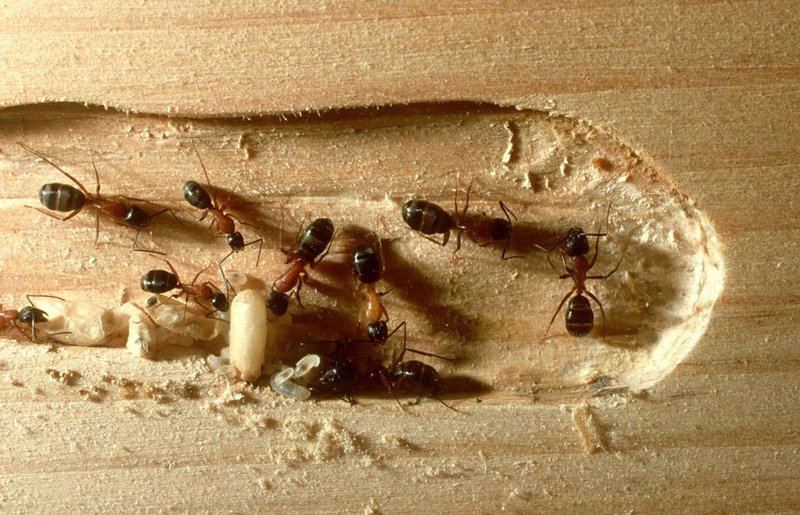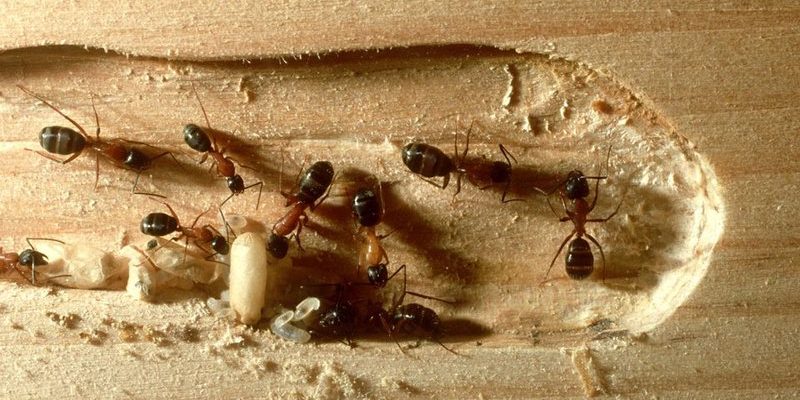
You might be surprised to learn that carpenter ants aren’t about building like their name suggests. Instead, they’re more like skilled remodelers, turning your wooden structures into their cozy nests. Of course, while they might be intriguing little creatures, they can also signal trouble if they invade your space. Let’s dive into some interesting facts about carpenter ants that might just change how you see these tiny yet incredible insects.
1. Carpenter Ants Aren’t Actually Wood-Eaters
Here’s the thing: despite their name, carpenter ants don’t actually eat wood. They prefer to munch on protein and sugar sources, like insects or honeydew from aphids. When they tunnel through wood, they’re not feasting on it—they’re creating nests. Think of it as a construction project where they repurpose wood, not for a snack but for shelter.
This behavior is a bit like how some people repurpose furniture. You know, the folks who take old wood and turn it into beautiful coffee tables? Carpenter ants are just repurposing what’s available. They’ll dig into soft, damp wood, which is easier to carve out. This is why you often find them in older homes or areas with water damage.
2. They Have a Hierarchical Society
Carpenter ants live in colonies that can consist of thousands of individuals. Within these colonies, there’s a whole pecking order. At the top is the queen, whose primary job is to lay eggs. You might think of her as the CEO of the colony—she’s crucial for growth and reproduction.
Then there are worker ants, which are responsible for foraging, maintaining the nest, and defending the colony. If you’ve ever seen a line of ants on a mission, those are likely the workers out looking for food. They communicate through pheromones, a kind of chemical language, which helps them coordinate efforts and keep their tasks organized.
3. Carpenter Ants Can Be Found in Many Climates
You might think carpenter ants only thrive in specific locations, but you’d be surprised! These ants are adaptable and can live in various climates, from forests to urban areas. They’re commonly found in the United States and Canada, but their presence isn’t limited to just these regions.
Depending on the climate, their behavior can change. In cooler regions, carpenter ants may winter indoors, seeking out warm, damp spots to nest. In warmer climates, they can be found burrowing into trees or wooden structures, illustrating just how versatile they really are.
4. They Are Active at Night
If you’ve ever wondered why you don’t see carpenter ants during the day, it’s because they’re nocturnal. Most of their activity happens at night when it’s quieter and safer from predators. Imagine a little party happening under the cover of darkness, with these tiny creatures buzzing about their tasks, oblivious to the daylight above.
This nocturnal behavior can sometimes lead to trouble for homeowners. If you hear rustling sounds at night, it might be these ants getting to work. That’s why setting traps or looking for signs of their presence during the day can be tricky.
5. Carpenter Ants Can Cause Damage
While carpenter ants may not eat wood, they can still wreak havoc on your home if they decide to take up residence. Their tunneling can cause structural damage—think of it as a hidden remodeling project gone wrong. You might not see the impact right away, but over time, it can compromise the integrity of wooden beams and other essential supports.
To put it in perspective, a small colony might not cause noticeable damage, but left unchecked, a large infestation can lead to significant repair costs. It’s always a good idea to catch the signs early, whether that’s through regular inspections or paying attention to any unusual sounds in your home.
6. They Play a Role in the Ecosystem
Carpenter ants aren’t just pests; they also play an important role in the ecosystem. By breaking down decaying wood, they help recycle nutrients back into the soil, fostering new growth. It’s like they’re nature’s little cleanup crew—doing their part to keep the environment healthy.
Their presence can also encourage biodiversity. By creating nesting sites in wood, they provide habitats for other species, including fungi and smaller insects. So, while you might find them annoying when they invade your space, they are quite beneficial in nature.
7. Different Colors and Sizes
Carpenter ants come in a variety of colors and sizes, which can be quite surprising. While many people think of them as black, they can also be reddish or even a combination of colors. Their size can range from about 1/4 inch to 1/2 inch long—quite a range for such small creatures!
This diversity can sometimes lead to confusion. When identifying them, look for their smooth, rounded bodies and the distinctive shape of their antennae. It’s like meeting different personalities in the same family; they might look a bit different, but they’re all part of the same group.
8. They Can Be Tricky to Eliminate
If you discover carpenter ants in your home, getting rid of them can be a real challenge. Because they often nest inside the wood, finding their *exact location* can be like searching for a needle in a haystack. You might spray insecticide, but if you don’t locate the nest, the problem might persist.
It’s a bit like following a scent trail while blindfolded—you might be close, but you can’t quite find the source. Sometimes, calling in a professional pest control service is the best way to tackle the problem, especially if the infestation is serious.
9. They Can Live for Years
Carpenter ants have quite a long lifespan compared to other insects. Queens can live for years, and even worker ants can survive for a few years if conditions are favorable. This longevity is part of why infestations can become so challenging—they can keep reproducing and expanding their colonies year after year.
Imagine living in a tiny community that can last for generations. Their ability to thrive so long increases their chances of finding food and shelter, making it essential to keep an eye out for signs of their presence.
10. They’re Surprisingly Intelligent
You might not think of ants as particularly smart creatures, but carpenter ants display remarkable intelligence. They can adapt their behaviors based on changing environments and challenges, much like we do. For instance, if they encounter a barrier, they’ll work together to find a new route, showing a level of problem-solving that’s quite impressive.
Their communication skills also hint at their intelligence. When foraging, if one ant finds a food source, it will mark the trail for others to follow. This kind of teamwork is fascinating and demonstrates a level of social organization that many insects lack.
In conclusion, carpenter ants are complex little creatures that do more than just crawl around your home. From their unique nesting habits to their essential role in the ecosystem, they’re much more than just pests. While they can cause damage if not kept in check, understanding their behavior can help us coexist better with them. If you suspect a carpenter ant problem in your home, don’t hesitate to act quickly and seek solutions to keep your space safe. Who knew learning about these tiny carpenters could be so eye-opening?

